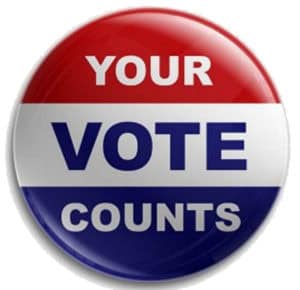Revised 2025

Take Political Action for Science
Quickguide
How to Vote Checklist
Voting is a fundamental democratic right. This short guide is designed to help first-time voters in the United States navigate the voting process from start to finish. Follow these simple steps to ensure your voice is heard.
1. Register to Vote
Check your registration status or register here: vote.org/register-to-vote
Be aware of your state’s voter registration deadline (usually several weeks before Election Day).
2. Know Your Options for Voting
In Person on Election Day – Go to your assigned local polling place.
Early Voting – Many states allow voting in person before Election Day at select locations.
Vote by Mail (Absentee Voting) – Request an absentee ballot (if allowed in your state), fill it out, and return it on time.
3. Find Out What’s on the Ballot
Learn about candidates, propositions, and ballot measures at: ballotpedia.org
Research your choices at the local, state, and national levels before voting.
4. Make a Voting Plan
Decide how and when you will vote (by mail, early, or on Election Day).
Find your polling place here: nass.org/Can-I-Vote
Bring a valid ID if required in your state (check your state’s rules in advance).
5. Vote!
Vote early if possible to avoid long lines and reduce risk of any issues.
If voting by mail, send your ballot back early to meet the deadline.
Your vote matters. Make it count!
6. Track Your Ballot (If Voting by Mail)
Many states offer ballot tracking services via email, SMS, or online portals.
If you’re unsure about your ballot status, contact your local election office for help.
7. Stay Informed for Future Elections
Subscribe to updates from nonpartisan sources like vote.org and ballotpedia.org.
Follow trusted civic and science advocacy groups aligned with your values.

Would you like me to convert this into HTML for direct pasting into WordPress’s code editor or blog backend?

How to Vote!
Voting is one of the most important rights and responsibilities of citizenship. But how you vote—and when—depends on the rules set by your state and local election officials.
In the U.S., state governments set the rules for voter registration and election procedures, while county auditors typically oversee the logistics—such as polling places and early voting schedules.
Three Main Ways to Vote
- Vote by Mail (Absentee or Universal Mail Voting)
- Vote Early In Person (at designated polling sites before Election Day)
- Vote on Election Day (in person at your assigned polling place)
1. Early Voting
- Available in 37 states to all registered voters—no excuse required.
- In-person absentee voting (in the remaining 13 states) requires a valid reason and is also done by mail-in ballot.
- Early voting can start as early as 45 days before an election, though most begin about 20 days prior.
Early voting is highly recommended for those with busy schedules or transportation concerns—it provides flexibility and helps avoid long lines on Election Day.
Check your state’s early voting calendar here.
2. Voting by Mail (Absentee Voting)
Any registered voter can request an absentee ballot—though some states require an excuse. Once approved, a ballot is mailed to you, which you can return by mail or official drop box.
- States like Oregon, Washington, and Colorado automatically mail ballots to all registered voters and no longer use in-person voting precincts.
- Military and overseas voters often rely on absentee ballots as their primary option.
- Absentee ballots must be requested and returned by state-specific deadlines. Late or missing ballots are a common issue, so act early.
3. Voting In Person on Election Day
- Polling locations are assigned based on your home address.
- Bring a valid form of ID—ID requirements vary by state.
- Find your polling place here.
Voting by Mail from Overseas or on Active Duty
If you’re a military or overseas voter, use the Federal Voting Assistance Program (FVAP):
- Visit: www.fvap.gov
- Select your state of voting residence from the drop-down menu.
- Download the Federal Post Card Application (FPCA) to register and request ballots.
- If your ballot hasn’t arrived 30 days before the election, use the Federal Write-In Absentee Ballot (FWAB) as a backup.
You must submit a new FPCA each calendar year to remain eligible.
Depending on your state, you can:
- Receive ballots via mail, email, or fax
- Return them via courier (FedEx/UPS) or drop them off at a U.S. embassy or consulate using the Diplomatic Pouch
Visit your embassy’s website or contact a Voting Assistance Officer for step-by-step instructions.
Download postage-paid return envelopes and printable materials at the FVAP website.
Final Steps





Check your registration and deadlines at Vote.org.
Congratulations—You Voted!
Voting is the cornerstone of a functioning democracy. Whether you voted by mail, early, or on Election Day, you’ve taken a meaningful step to shape your community, your country, and your future.
Next up: Now that you know how to vote, let’s dive into why your vote matters. Continue reading to explore the political parties, offices, and policies that shape society—and how your vote can drive change at every level of government.

Civic Action Toolkit: Educate Yourself and Make Contact
Making your voice heard in government doesn’t require a law degree or political connections. With a little preparation, you can become an effective advocate for science, human rights, and evidence-based policy.
Here’s a simple, step-by-step plan—with easy instructions and trusted resources—to educate yourself, contact your representatives, and make the most of your civic engagement:
1. Learn About Current Legislation
- Congress.gov – Official site for U.S. federal legislative information
- GovTrack.us – Nonpartisan tracker of bills, votes, and members of Congress
2. Find Your Representatives
- House.gov – Find your U.S. Representative
- Senate.gov – Find your U.S. Senators
- USA.gov State Contacts – Governors, attorneys general, and more
3. Write to Your Members of Congress
- Democracy.io – Write directly to your lawmakers
- ThoughtCo – How to Write to Congress
- WriteExpress – Sample Letters
- ACLU – Sample Letters to Congress
4. Call Your Members of Congress
5. Meet with Your Lawmakers Face-to-Face
6. Contact State Officials
7. Write or Call the White House
8. Subscribe for Updates
- Subscribe to Science Abbey alerts and blog updates
- Visit the “How to Vote Quickguide” on the Science Abbey website
- Watch for: “Scientists’ Guide to American Government” (Coming soon)
Bonus: Advocacy Toolkit
- ASBMB Advocacy Toolkit – Templates, tools, and action strategies
Every email, every phone call, every vote matters.
Use your voice. Use your tools. Change starts with you.




